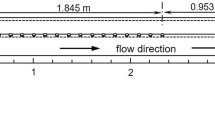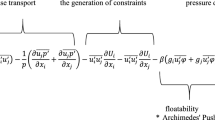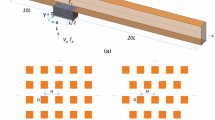Abstract
Turbulent flows are characterised by the presence of 'fluctuating scales', or 'structures' of varying magnitude whose effects on mixing, heat transfer and energy dissipation are prominent. The main objective of the study is to explore and exploit two-equation models capable of numerically analysing the dynamic and thermal behaviour of unsteady turbulent incompressible flows, focusing on the variation of temperatures and the rate of turbulent dissipation in a hydraulic structure of complex geometry with its obstacles, erected along the axis of the open channel. The complexity of the physical phenomena taking place in the circular tunnel and the trapezoidal open channel was also emphasised. The work also includes the various numerical simulations that we were able to carry out using the FUENT software, which allowed us to visualise the vortex structures and the energy dissipation. The simulations were carried out using the Reynolds-averaged Navier–Stokes (RANS) model using the closure models: k-ε, RNG k-ε, SST k-ω and K-ω. This model was chosen because it is less expensive in terms of computational time than Direct numerical simulation and large-scale simulations have a very wide range of applications, including heat transfer. The resolution of the incompressible Navier–Stokes equations governing these flows is carried out with the finite volume method, the use of which is particularly motivated by its ability to handle complex geometries. All the simulations were carried out using the FLUENT software, which allowed us to explore, among other things, the turbulent kinetic energy and the temperature distribution in the set-up.


















Similar content being viewed by others
References
Batchelor GK (1953) The theory of homogeneous turbulence. Cambridge UniversityPress
Benahmed L (2020) Etude de la turbulence dans un ecoulement etabli avec transfert de chaleur. Université AbouBakrBelkaid, Tlemcen, Algérie
Guillaume H (2004) Estimation du taux de dissipation d’énergie cinétique turbulente
Khanfouf O, Fourar A (2021) Numericalmodeling of isothermalhomogeneous turbulent fows by fnite volumes in a compound hydraulicscheme. Modeling Earth Syst Environ. https://doi.org/10.1007/s40808-021-01196-3
Khanfouf O, Fourar A, Massouh F, Zeroual A, Chiremsel R (2021) Modelingunsteady turbulent fowsaround immersed obstacles in a channel with complex geometry. Modeling Earth Syst Environ 8:3907–3926
Kumar SS, Arul Prakash K (2013) An RNG based K-Epsilon turbulence model using the realizableeddyviscosity formulation. In: 14th European Turbulence Conference (ETC14), 1–4 September 2013, Lyon, France
Labert CJ (2012) Simulation numérique d’écoulements turbulents en rotation, confinement et forçage à l’aide d’une méthode de pénalisation. Autre. Ecole Centrale de
Launder BE, Spalding DB (1974) The numerical computation of turbulent flows. Comp Meth Appl Mech Eng 3(2):269–289
Menter FR (1994) Two-equationeddy-viscosity turbulence models for engineering applications. AIAA J 32(8):1598–1605
Menter FR (2009) Review of the shear-stress transport turbulence model experiencefrom an industrial perspective. Int J Comput Fluid Dyn 23(4):305–316
Mohammadi B, Pironneau O (1993) Analysis of the K-epsilon turbulence model
Nicoud F (1990) Mécanique des Fluides. Polytechnic Montpellier
Romanova D et al (2022) Calibration of the k-ω SST turbulence model for free surfaceflows on mountainslopesusing an experiment. Fluids 7(3):111
Roy M (2006) Caractérisation de l’écoulement turbulent en rivière à lit de graviers peu profonde Stratégie d’échantillonnage, interpolation et structure spatiale. Université de Montréal
Schiestel R (2005) Modèle de turbulence générique à deux équations de transport
Večenaj Z, Belušid D, Grisogono B (2007) Estimation of turbulence kinetic energy dissipation rate in a bora event. In: Proc. 29th Intern. Conf. on Alpine Meteorology, Chambery, France, pp 745–748
Viollet P-L, Chabard J-P, Esposito P (1998) Mécanique des fluides appliquée : écoulements incompressibles dans les circuits, canaux et rivières, autour des structures et dans l’environnement. 1998 Presses de l’Ecole Nationale des Ponts et Chaussées. Paris
Yakhot V, Orszag SA, Thangam S, Gatski TB, Speziale CG (1992) Development of turbulence models for shearflows by a double expansion technique. Phys Fluids A 4(7):1510–1520
Zhang D (2017) Comparison of various turbulence models for unsteady flow around a finitecircularcylinder at Re=20000. J Phys. https://doi.org/10.1088/1742-6596/910/1/012027
Author information
Authors and Affiliations
Corresponding author
Additional information
Publisher's Note
Springer Nature remains neutral with regard to jurisdictional claims in published maps and institutional affiliations.
Rights and permissions
Springer Nature or its licensor (e.g. a society or other partner) holds exclusive rights to this article under a publishing agreement with the author(s) or other rightsholder(s); author self-archiving of the accepted manuscript version of this article is solely governed by the terms of such publishing agreement and applicable law.
About this article
Cite this article
Khanfouf, O., Fourar, F.Z., Fourar, A. et al. Influence of model selection on the temperature field and turbulent energy dissipation rate in a hydraulic system with a complex geometry. Model. Earth Syst. Environ. 9, 2125–2139 (2023). https://doi.org/10.1007/s40808-022-01591-4
Received:
Accepted:
Published:
Issue Date:
DOI: https://doi.org/10.1007/s40808-022-01591-4




